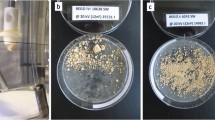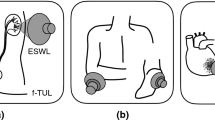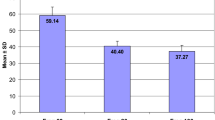Summary
Using the new electromagnetic shockwave source of the Modulith SL 20 shockwave-induced renal trauma was evaluated by acute and chronic studies in the the canine kidney model. In a further study the electromagnetic shockwave source of the Lithostar Plus Overhead module was tested. Overall, 92 kidneys were exposed to shock waves coupled either by water bath (Modulith lab type) or by water cushion (Modulith prototype, Lithostar Overhead) under ultrasound localization. The generator voltage ranged between 11 and 21 kV, the number of impulses between 25 and 2500. After application of 1500/2500 shocks the extent of the renal lesion depended strictly on the applied generator voltage and was classified into 4 grades: Grade 0, no macroscopic trauma detectable (at 11–12 kV); grade 1, petechial medullary bleeding (at 13 kV); grade 2, cortical hematoma (at 14–16 kV); and grade 3, perirenal hematoma (17–20 kV). Whereas at low and medium energy levels the number of shocks played only a minor role, at maximal generator voltage (20 kV) even 25 impulses induced a grade 2 and 600 shocks a grade 3 lesion, emphasizing the importance of shockwave limitation in the upper energy range. In shockwave-induced renal trauma a vascular lesion was predominant and cellular necrosis was secondary. Coupling with a water cushion resulted in a 15%–20% decrease in the disintegrative and traumatic effect, which was compensated for by increasing the generator voltage by 2 kV. Long-term studies showed complete restitution following grade 1 and 2 trauma, whereas after a grade 3 lesion a small segmental and capsular fibrosis without hyperplasia of the juxtaglomerular apparatus was observed. Based on the characteristic ultrasound pattern found in the first study, the threshold for induction of grade 1 lesion was investigated. With both lithotripters a wide range for induction of a grade 1 lesion (Modulith 234–411, Lithostar Plus 220–740) and also a significant overlapping with grade 0 and 2 lesions was seen at low energy settings (levels 2–4). In contrast, the range of shocks (Modulith 96–150, Lithostar Plus 90–142) and overlapping was minimal when high energy was used (levels 7–9). Finally, the disintegration-trauma coefficient combining the results obtained in a standard stone model with those of the canine kidney model was introduced.
Similar content being viewed by others
References
Abrahams C, Lipson S, Ross L (1988) Pathologic changes in the kidney and other organs of dogs undergoing extracorporeal shock wave lithotripsy with a tubless lithotriptor. J Urol 140:391–394
Baba S, Hata M, Nakanoma T, Tazaki H (1990) Long-term bioeffects of extracorporeal shock waves on rat kidneys. Akt Urol 21:93–96
Baumgartner BR, Dikey KW, Ambrose SS, Walton KN, Nelson RC, Bernardino ME (1987) Kidney changes after extracorporeal shock wave lithotripsy: appearance on MR imaging. Radiology 163:531–534
Brewer SL, Atala AA, Ackerman DM, Steinbock GS (1988) Shock wave lithotripsy damage in human cadaver kidneys. J Endourol 2:333–339
Charig C, Webb DR, Payne SR, Wickham JC (1986) Comparison of treatment of renal calculi by open surgery, percutaneous nephrolithotomy, and extracorporeal shock wave lithotripsy. Br Med J 292:879
Chaussy C (ed) (1982) Extracorporeal shock wave lithotripsy: new aspects in the treatment of kidney stone disease. Karger, Basle, pp 57–73
Chaussy C, Brendel W, Schmiedt E (1980) Extracorporeally induced destruction of kidney stones by shock waves. Lancet I:1265–1268
Chaussy C, Schmiedt E, Jocham D, Brendel W, Forssmann B, Walther V (1982) First clinical experience with extracorporeally induced destruction of kidneystones by shock waves. J Urol 127:417–420
Coleman AJ, Saunders JE (1989) A survey of the acoustic output of commercial extracorporeal shock wave lithotriptors. Ultrasound Med Biol 15:213–227
Das G, Birch B, Samuel C, Whitfield NH, Wickham JEA (1988) Enzymaturia as a marker of tubular recovery following extracorporeal shock wave lithotripsy. In: Lingeman JE, Newman DE (eds) Shock wave lithotripsy — state of the art. Plenum Press, New York, pp 369–370
David RD, Wolfson B, Barbaric Z, Fuchs GJ (1991) In-vivo model to investugate the risk of hypertension following high energy shock wave application to the kidney. J Urol 145:256A
Delius M, Enders G, Heine G (1987) Biological effects of shock waves: lung hemorrhage by shock waves in dogs — pressure dependence. Ultrasound Med Biol 13:61–67
Delius M, Enders G, Xuan Z (1988) Biological effects of shock waves: kidney damage by shock waves in dogs — dose dependence. Ultrasound Med Biol 14:117–122
Delius M, Jordan M, Eizenhoefer H, Marlinghaus E, Heine G, Liebich HG, Brendel W (1988) Biological effects of shock waves: kidney haemorrhage by shock waves in dogs — administration rate dependence. Ultrasound Med Biol 14:689–694
Eisenberger F, Chaussy C, Wanner K (1977) Extracorporale Anwendung von hochenergetischen Stoßwellen — Ein neuer Aspekt in der Behandlung des Harnsteinleidens. Akt Urol 8:3–15
Eisenberger F, Miller K, Rassweiler J (eds) (1991) Stone therapy in urology. Thieme, Stuttgart New York
El-Damanhoury H, Schaub T, Stadtbäumer M, Kunisch M, Störkel S, Schild H, Thelen M, Hohenfellner R (1991) Parameters influencing renal damage in extracorporeal shock wave lithotripsy: an experimental study in pigs. J Endourol 5:37–40
Evan AP, Willis LR, Connors BA, McAteer JA, Lingeman JE (1991) Renal injury by extracorporeal shock wave lithotripsy. J Endourol 5:25–35
Folberth W, Granz B, Köhler G (1991) What makes a stone break up? New understandings and technical implications. (Abst A-4) J Endourol 5:S-1
Fuchs AM, Fuchs GJ (1989) The effect of extracorporeally induced high energy shock waves on the rabbit kidney and ureter. J Urol 141:277A
Germinale F, Puppo P, Bottino P, Caviglia C, Ricciotti G (1989) ESWL and hypertension: no evidence for causal relationship. J Uro 141:241A
Grote R, Döhring W, Aeikens B (1986) Computertomographischer und sonographischer Nachweis von renalen und perirenalen Veränderungen nach einer extracorporalen Stoßwellenlithotripsie. Fortschr Röntgenstr 144:434–439
Ioritani N, Kuwahara M, Kambe K, Taguchi K, Shirai S, Orikasa S (1989) Arteriovenous fistula and subcapsular hematoma after extracorporeal shock wave applciation: animal experiments. J Urol 141:227A
Jaeger P, Redha F, Uhlschid G, Hauri D (1988) Morphological changes in canine kidneys following extracorporeal shock wave treatment. Urol Res 16:161–166
Jung P, Neisius D, Gebhardt T, Braedel HU, Seitz G, Rumpel H, Ziegler M (1990) Nierenveränderungen nach Applikation extra-corporaler Stoßwellen mit dem neuen Piezolith 2500 beim Hund. Vorgestellt beim 10. Symposium für Experimentelle Urologie, München 1990
Karlsen SJ, Smevik B, Klingenberg-Lund K, Berg KJ (1991) Do extracorporeal shock waves affect urinary excretion of glucosaminoglycans? Br J Urol 67:24–28
Kaude JV, Williams CM, Millner MR, Scott KN, Finlayson B (1985) Renal morphology and function immediately after extracorporeal shock wave lithotripsy. Am J Radiol 145:305–313
Kitada S, Kuramoto H, Kumazawa J, Yamaguchi A, Nakasu H, Hara S (1989) Effects of extracorporeal shock wave lithotripsy on urinary excretion of N-acetyl-beta-d-glucosamidase. Urol Int 44:35–37
Knapp PM, Kulb TB, Lingeman JE, Newman DM, Metrz JH, Mosbaugh PG, Steele RE (1988) Extracorporeal shock wave lithotripsy-induced perirenal hematomas. J Urol 139:700–703
Köhrmann KU, Rassweiler J, Weber A, Kahmann F, Berle B, Wess O, Alken P (1991) Threshold energy of shock waves initiating different grades of lesions in the canine kidney. (Abst A-17) J Endourol 5:S47
Kopper B, Riedlinger R, Stoll HP, Göbbels R, Gebhardt T, Ziegler M (1987) Piezoelektrische Lithotripsie — experimentelle Untersuchungen. In: Ziegler M (Hrsg) Die extrakorporale und laserinduzierte Stoßwellenlithotripsie bei Harn und Gallensteinen. Springer, Berlin Heidelberg New York, S 46–49
Liedl B, Jocham D, Lunz C, Schuster C, Chaussy Ch (1989) Prävalenz und Inzidenz der arteriellen Hypertonie bei ESWL-behandelten Nierensteinpatienten. Urologe [A] 28:130–133
Lingeman JE, Kulb TB (1987) Hypertension following ESWL. J Urol 137:142A
Littleton RH, Melser M, Kupin W (1989) Acute renal failure following bilateral extracorporeal shock wave lithotripsy without ureteral obstruction. In: Lingeman JE, Newman DM (eds) Shock wave lithotripsy vol II: Urinary and biliary lithotripsy. Plenum Press, New York, pp 197–201
Muschter R, Schmeller NT, Reimers I, Kutscher KR, Knipper A, Hofstetter AG, Löhrs U (1987) ESWL-induced renal damage an experimental study. Invest Urol 2:194–197
Neisius D, Seitz G, Gebhardt T, Ziegler M (1989) Dose-dependent influence on canine renal morphology after application of extracorporeal shock waves with Wolf Piezolith. J Endourol 3:337–345
Newman RC, Feldman J, Hachett R, Sosnowski J, Senior D, Finlayson B, Brock K (1987) Pathologic effects of ESWL on canine renal tissue. Urology 29:194–200
Rassweiler J, Alken P (1990) State of the art: limitations and future trends of shock-wave lithotripsy. Urol Res 18 [Suppl]:13–23
Rassweiler J, Eisenberger F, Buck J (1983) Das stumpfe Nierentrauma — operative oder konservative Therapie? Ein Beitrag zur Klassifikation Unfallchirurgie. 9:274–279
Rassweiler J, Köhrmann U, Heine G, Back W, Wess O, Alken P (1990) Modulith SL 10/20 — Experimental introduction and first clinical experience with a new interdisciplinary lithotriptor. Eur Urol 18:237–241
Rassweiler J, Köhrmann KU, Marlinghaus EH, Heine G, Alken P (1991) Threshold of shock wave energy for different degress of renal trauma in the canine kidney model. J Urol 145:255A
Recker F, Ruebben H, Bex A, Constantinides C (1989) Morphological changes following ESWL in the rat kidney. Urol Res 17:229–233
Rigatti P, Colombo R, Centemero A, Francesca F, Girolamo V di, Montorsi F, Trabucchi E (1989) Histological and ultrastructural evaluation of extracorporeal shock wave lithotripsy-induced acute renal lesions: preliminary report. Eur Urol 16:207–211
Rubin JI, Arger PH, Pollack HM, Banner MP, Coleman BG, Mintz MC, Arsdalen KN van (1987) Kidney changes after extracorporeal shock wave lithotripsy: CT evaluation. Radiology 162:21–24
Ryan PC, Jones BJ, Kay EW, Nowlan P, Kiely EA, Gaffney EF, Butler MR (1991) Acute and chronic bioeffects of single and multiple doses of piezoelectric shock waves (EDAP LT.01). J Urol 145:399–404
Schmidt A, Müller M, Wilke J, Eisenberger F (1990) Intrakorporale Druckmessungen in Nierenbecken und Harnleiter während der extrakorporalen Stoßwellenlithotripsie. Präsentiert anläßlich der 42. Jahrestagung der Deutsche Gesellschaft für Urologie, Hamburg 1990
Seitz G, Pletzer K, Neisius D, Dippel W, Gehbardt T (1991) Pathologic-anatomic alterations in human kidneys after extracorporeal piezoelectric shock wave lithotripsy. J Endourol 5:17–20
Servadio C, Livne P, Winkler H (1988) Extracorporeal shock wave lithotripsy using a new, compact and portable unit. J Urol 139:685–688
Thibault P, Dory J, Cotard JP, Moraillon JY, Vallancien G, André-Bougaran J (1986) Lithotripsie à impulsions ultra-courtes. Ann Urol 20:20–25
Trinchieri A, Zanetti G, Tombolini P, Mandressi A, Ruoppolo M, Tura M, Montanari E, Pisani E (1990) Urinary NAG excretion after anesthesia-free extracorporeal lithotripsy of renal stones: a marker of early tubular damage. Urol Res 18:259–262
Vergunst H, Terpstra OT, Schröder F, Matura E (1989) Assessment of shock wave pressure profiles in vitro: clinical implications. J Lithotripsy Stone Disease 1:289–298
Wilbert D, Lang L, Riedmiller H, Alken P, Hohenfellner R (1986) Tierexperimentelle Untersuchungen zur Anwendung einer neuen Stoßwellen-Quelle zur extracorporalen Stoßwellenlithotripsie. Vorgestellt beim 8. Symposium für Experimentelle Urologie, Mainz, 1986
Zwergel T, Neisius D, Zwergel U, Becht E (1989) Hypertension in patients with extracorporeal lithotripsy of urinary stones — incidence in first- and second-generation lithotriptor treatment. J Urol 141:242A
Author information
Authors and Affiliations
Rights and permissions
About this article
Cite this article
Rassweiler, J., Köhrmann, K.U., Back, W. et al. Experimental basis of shockwave-induced renal trauma in the model of the canine kidney. World J Urol 11, 43–53 (1993). https://doi.org/10.1007/BF00182171
Issue Date:
DOI: https://doi.org/10.1007/BF00182171




